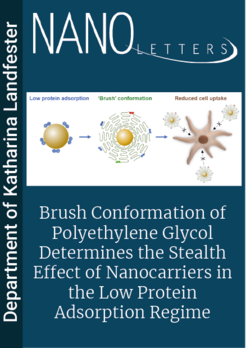Brush Conformation of Polyethylene Glycol Determines the Stealth Effect of Nanocarriers in the Low Protein Adsorption Regime

Researchers at the Max Planck Institute for Polymer Research report that by tailoring the conformation of PEG on low protein affinity nanocarriers, they can considerably reduce the uptake of nanocarriers in cells. The researchers covalently attached PEG to nanocarriers at varied chain lengths and densities, which resulted in PEG chain with a mushroom or brush conformation. They found that the PEG conformation determines protein corona patterns and abundance of distinct proteins in the corona. The PEG chains with a brush conformation led to increased adsorption of clusterin and decreased serum albumin abundance in the corona. The PEG brush conformation at the low adsorbance protein regime, together with clusterin-enriched surface, led to a stealth behavior of nanocarriers with inhibited phagocytic uptake. A clear correlation between PEG conformation and the stealth behavior of resulting nanocarriers was established. The findings are published in the Journal “Nano Letters”.












